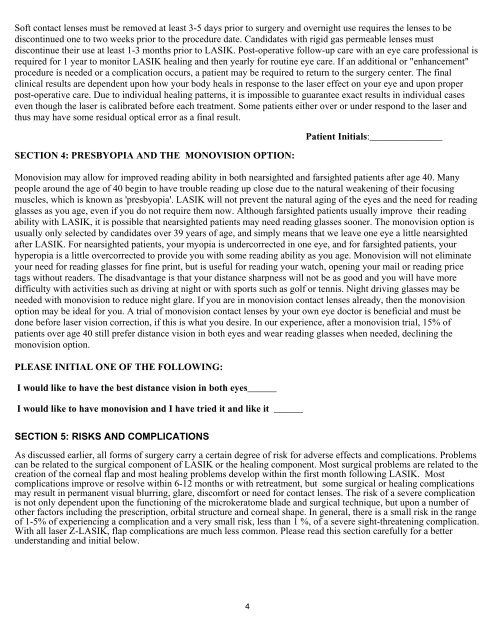lasik informed consent - initial - Braverman Eye Center
lasik informed consent - initial - Braverman Eye Center
lasik informed consent - initial - Braverman Eye Center
You also want an ePaper? Increase the reach of your titles
YUMPU automatically turns print PDFs into web optimized ePapers that Google loves.
Soft contact lenses must be removed at least 3-5 days prior to surgery and overnight use requires the lenses to be<br />
discontinued one to two weeks prior to the procedure date. Candidates with rigid gas permeable lenses must<br />
discontinue their use at least 1-3 months prior to LASIK. Post-operative follow-up care with an eye care professional is<br />
required for 1 year to monitor LASIK healing and then yearly for routine eye care. If an additional or "enhancement"<br />
procedure is needed or a complication occurs, a patient may be required to return to the surgery center. The final<br />
clinical results are dependent upon how your body heals in response to the laser effect on your eye and upon proper<br />
post-operative care. Due to individual healing patterns, it is impossible to guarantee exact results in individual cases<br />
even though the laser is calibrated before each treatment. Some patients either over or under respond to the laser and<br />
thus may have some residual optical error as a final result.<br />
SECTION 4: PRESBYOPIA AND THE MONOVISION OPTION:<br />
Patient Initials:_______________<br />
Monovision may allow for improved reading ability in both nearsighted and farsighted patients after age 40. Many<br />
people around the age of 40 begin to have trouble reading up close due to the natural weakening of their focusing<br />
muscles, which is known as 'presbyopia'. LASIK will not prevent the natural aging of the eyes and the need for reading<br />
glasses as you age, even if you do not require them now. Although farsighted patients usually improve their reading<br />
ability with LASIK, it is possible that nearsighted patients may need reading glasses sooner. The monovision option is<br />
usually only selected by candidates over 39 years of age, and simply means that we leave one eye a little nearsighted<br />
after LASIK. For nearsighted patients, your myopia is undercorrected in one eye, and for farsighted patients, your<br />
hyperopia is a little overcorrected to provide you with some reading ability as you age. Monovision will not eliminate<br />
your need for reading glasses for fine print, but is useful for reading your watch, opening your mail or reading price<br />
tags without readers. The disadvantage is that your distance sharpness will not be as good and you will have more<br />
difficulty with activities such as driving at night or with sports such as golf or tennis. Night driving glasses may be<br />
needed with monovision to reduce night glare. If you are in monovision contact lenses already, then the monovision<br />
option may be ideal for you. A trial of monovision contact lenses by your own eye doctor is beneficial and must be<br />
done before laser vision correction, if this is what you desire. In our experience, after a monovision trial, 15% of<br />
patients over age 40 still prefer distance vision in both eyes and wear reading glasses when needed, declining the<br />
monovision option.<br />
PLEASE INITIAL ONE OF THE FOLLOWING:<br />
I would like to have the best distance vision in both eyes______<br />
I would like to have monovision and I have tried it and like it ______<br />
SECTION 5: RISKS AND COMPLICATIONS<br />
As discussed earlier, all forms of surgery carry a certain degree of risk for adverse effects and complications. Problems<br />
can be related to the surgical component of LASIK or the healing component. Most surgical problems are related to the<br />
creation of the corneal flap and most healing problems develop within the first month following LASIK. Most<br />
complications improve or resolve within 6-12 months or with retreatment, but some surgical or healing complications<br />
may result in permanent visual blurring, glare, discomfort or need for contact lenses. The risk of a severe complication<br />
is not only dependent upon the functioning of the microkeratome blade and surgical technique, but upon a number of<br />
other factors including the prescription, orbital structure and corneal shape. In general, there is a small risk in the range<br />
of 1-5% of experiencing a complication and a very small risk, less than 1 %, of a severe sight-threatening complication.<br />
With all laser Z-LASIK, flap complications are much less common. Please read this section carefully for a better<br />
understanding and <strong>initial</strong> below.<br />
4






